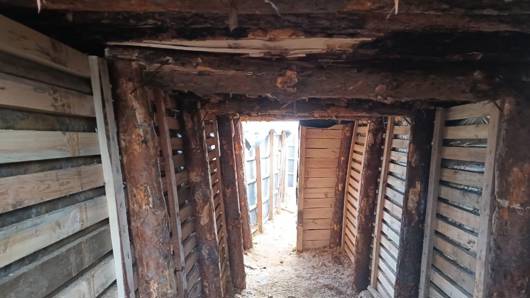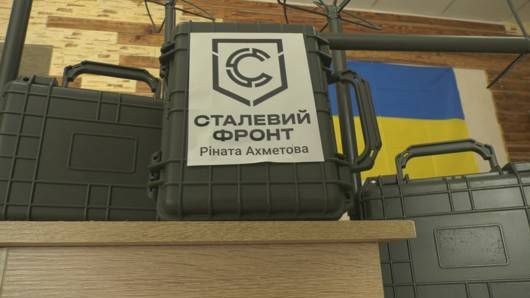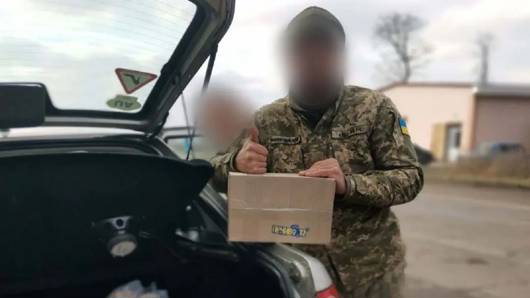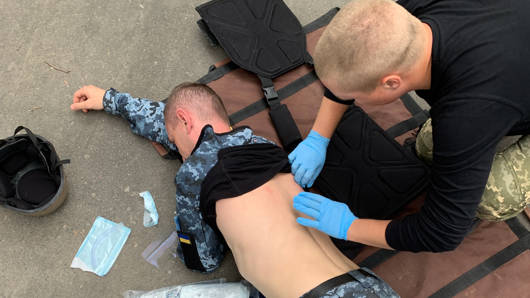At the Pryamyy Channel studio, Olexandr Myronenko, the Chief Operations Officer of Metinvest Group, told about the work of Rinat Akhmetov's Steel Front, the safety of soldiers at the front line, the construction of fortifications, cooperation with the military and plans to launch new products for frontline use.
"The construction of fortifications is currently being actively discussed in society. How did it all start for Rinat Akhmetov's Steel Front? When did you join this process?
We at Metinvest joined the process at the beginning of the full-scale invasion. We were tasked by the military to fortify the cities where our businesses are located. Therefore, we began constructing fortifications around these areas. We supplied resources, machinery and manpower to block roads, make anti-tank ditches and prevent the occupiers from advancing.
On a much larger scale in the Donetsk and Zaporizhzhia directions, we got involved in late autumn last year. Since then, we have been involved 24/7 in the construction of fortifications that are now helping to defend the country."
"What exactly are these fortifications?"
"This is a system of platoon strongholds and company strongholds, which are equipped with communication routes and reinforced with anti-tank ditches that prevent vehicles from accessing these fortifications. Each platoon stronghold has dugouts where military staff can hide. There are slits to wait out shelling. There are recesses to hide from drones. In other words, it is a system of fortifications that enables the military to conduct combat operations and ensures their safety when the enemy launches air or artillery strikes."
"Are there any challenges you face when building fortifications?"
"The main challenge is the safety of workers in that area. We have an agreed system with the military. For example, if we are excavating within 5-7 kilometres of the “zero line”, an area vulnerable to enemy artillery fire, we do not send our people to build fortifications. Instead, only our excavators and operators of excavators work there. Sometimes we just provide an excavator, and the military sends their own operator. It is dangerous there, and civilians cannot be sent there.
When we work 15-20 kilometres away from “zero line”, we also engage our own teams to not disturb the military from their work. Representatives from the Steel Front participate in building defence areas and their arrangement."
"Can you describe how the process of cooperation with the military looks like?"
"The cooperation process looks like this: there is a Civil-Military Administration responsible for organizing defence lines. Certain funds are allocated for this purpose. There are engineer forces. There is the State Special Transport Service, which carries out construction work. And there is a private business that is ready to join the construction of fortifications. It's not just Rinat Akhmetov's Steel Front and Metinvest, but many other businesses. Each of them is assigned a specific area to equip. Then military engineers mark on a map what and where should be built in terms of tactics and strategy.
After that, we go to the construction site. Depending on the distance to the “zero line”, we either do turnkey work or carry out earthworks and supply materials, while the military equip the facilities. The advantage of a private involvement is that we do everything faster than the state."
"Metinvest also produces steel shelters. What is the feedback from the military about them?"
"This product has already been approved by the Ministry of Defence and the engineer forces and is used to build fortifications.
We have made several modifications to the shelters. Depending on the needs of the military, the shelter can be 2x12 metres in size and can be used as a field headquarters. A set of 5-6 individually equipped steel shelters functions as a command post.
We have already developed a shelter for position observation. It is a small 2x3 metres in size and is utilized in the Donetsk direction for drone crews, providing opportunity to hide during artillery fire.
We are also finishing another significant project, a large underground hospital made of steel shelters. This medical facility is expected to be the first of its kind in Ukraine and may be situated near the front line. The military is satisfied with our products."
"Apart from shelters, what else do Ukrainian defenders ask for?"
"Drones and electronic warfare (EW) equipment. Even if we are talking about building fortifications, we equip each of our points where equipment is working with EW. Unfortunately, the enemy already has drones that can operate within a range of 15-20 kilometres, and we need electronic warfare to jam them. The Steel Front buys these things and supply them to the military.’
"You mentioned electronic warfare equipment. As far as I understand, you will develop this area to deploy them at every location where Ukrainian soldiers are stationed. What other plans do you have?"
"What plans do we have? We are developing and producing different types of armour steel and other products for our defence industry, which is now being restored.
Armor steel is utilized to shield machine gunners, strengthen armoured personnel carriers, and manufacture a large list of other equipment and facilities. We will focus on products aimed at protecting our guys and girls at the frontline.









